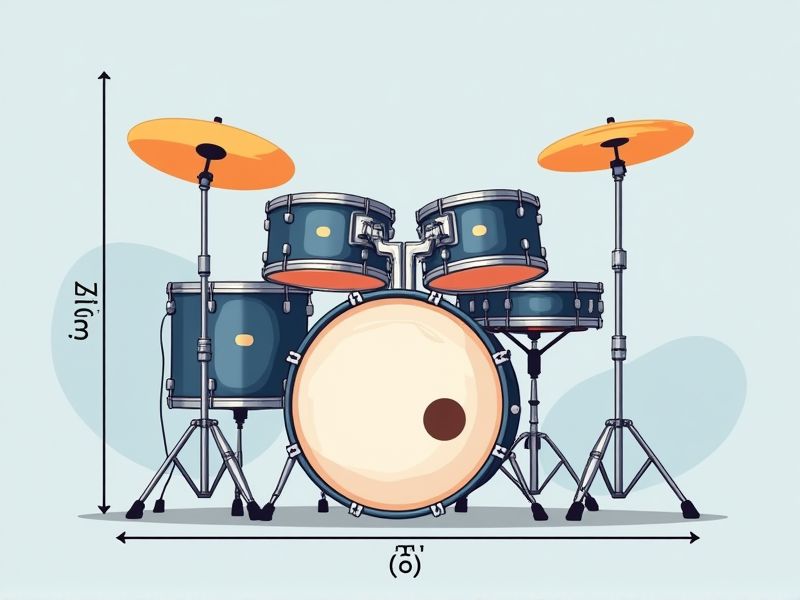
When selecting a drum set, understanding standard dimensions helps ensure comfort and playability. Typically, a bass drum measures 22 inches in diameter and 18 inches in depth, while snare drums are commonly 14 inches by 5.5 inches. Standard toms range from 10 to 14 inches in diameter, with floor toms usually at 16 inches. These sizes accommodate most musical styles and provide a balanced sound, making them a reliable choice for both beginners and experienced drummers.
Bass Drum Size
The bass drum, a crucial component of a drum set, typically measures between 18 to 22 inches in diameter, with 20 inches being the most common size used in diverse musical genres. A larger bass drum, such as a 24-inch model, produces a deeper, fuller sound that is favored in genres like rock and jazz, providing a powerful foundation for your rhythm. Conversely, a smaller bass drum, around 18 inches, offers a punchier tone that is ideal for fast-paced styles, such as punk or pop. Your choice of bass drum size significantly impacts the overall sound and playability of the drum set, shaping the character of the music you create.
Snare Drum Diameter
The standard snare drum diameter typically measures 14 inches, a size favored for its versatility across various musical genres. This dimension allows for a balanced tone, providing both sharp attack and warm resonance. When selecting a snare drum, consider the depth as well; common measurements range from 5 to 7 inches, impacting the overall sound character. A well-chosen snare can enhance your drumming experience, delivering precision and clarity in rhythm.
Tom Sizes
The standard sizes for toms on a drum set typically fall within the range of 10 inches to 16 inches in diameter. For a balanced sound, the most common configurations include a rack tom of 10 inches or 12 inches and a floor tom of 14 inches or 16 inches. These sizes allow for optimal tonal range, with smaller toms producing higher pitches and larger toms delivering deeper tones. Understanding these measurements helps you choose the right setup for your musical style and preferences.
Floor Tom Dimensions
A standard floor tom typically measures between 14 to 16 inches in diameter and ranges from 12 to 16 inches in depth. This size provides a deep, resonant sound that complements the tonal range of the drum set. You can find floor toms constructed from various materials, such as maple or birch, which significantly influence their sound characteristics. When selecting a floor tom, consider the drum's tuning range and how it integrates with your overall drum kit for optimal performance.
Drum Head Thickness
Drum head thickness plays a crucial role in defining the sound and tonal quality of a drum set. Typically measured in mils, standard drum heads range from 7 to 14 mils in thickness, influencing both the attack and sustain of the sound. Thinner heads, around 7 to 10 mils, produce a bright, resonant tone, while thicker heads, from 10 to 14 mils, offer a warmer sound with increased durability. When selecting drum heads for your set, consider how thickness will impact your overall playing style and genre preference, ensuring you achieve the desired sound characteristic for your music.
Shell Material
The standard of drum sets significantly depends on the shell material, which directly affects sound quality and resonance. Common shell materials include hardwoods like maple, birch, and mahogany, each offering distinct tonal characteristics; for instance, maple provides warmth and clarity, while birch delivers brighter tones with enhanced projection. Average shell thickness ranges from 6 to 9 millimeters, influencing durability and sound. For your ideal sound, consider the shell's material and thickness, as these factors play a crucial role in achieving the desired sonic experience.
Drum Depth
Drum depth significantly affects the sound quality and tonal characteristics of a drum set, influencing its overall performance in various musical genres. Standard drum depths typically range from 5 to 14 inches for snare drums and 8 to 24 inches for bass drums, allowing for a variety of resonance and projection. A deeper drum often produces a lower pitch and more sustained sound, ideal for rock or jazz, while shallower drums yield a higher pitch and sharper attack, suitable for funk or pop. When selecting your drum set, consider how depth aligns with your desired sound and playing style to achieve optimal results.
Hoop And Rim Type
A drum set's hoop and rim type significantly impacts its sound and functionality. Typically, there are two primary types of hoops: die-cast and triple-flanged, with die-cast offering enhanced tuning stability and resonance, while triple-flanged provides a brighter tone. The rim type also plays a crucial role; wooden rims tend to produce warmer sounds, whereas metal rims contribute to a sharper attack. Choosing the right combination can elevate your performance, allowing you to achieve the desired tonal characteristics for various musical styles.
Cymbal Size
Cymbal size significantly impacts your overall drum set sound and performance. Typically, cymbals range from 8 inches to 22 inches in diameter, with larger sizes producing lower, warmer tones, while smaller cymbals create higher, sharper sounds. For instance, a 14-inch crash cymbal delivers a quick, bright response, ideal for explosive accents, whereas a 20-inch ride cymbal offers a fuller, sustained sound suitable for rhythmic patterns. When choosing cymbal sizes, consider how each will complement your specific playing style and genres, ensuring an optimal balance in your drum set setup.
Hardware Configuration
The standard drum set typically comprises five key components: a bass drum, snare drum, two rack toms, and a floor tom, providing a versatile range of sounds. High-quality hardware configurations often include double-braced stands, ensuring stability and durability during performances. The ideal setup features adjustable pedals for both the bass drum and hi-hat, allowing you to tailor the response to your playing style. Investing in robust cymbal stands and reliable mounting systems enhances your overall drumming experience, giving you the confidence to express your musicality fully.
